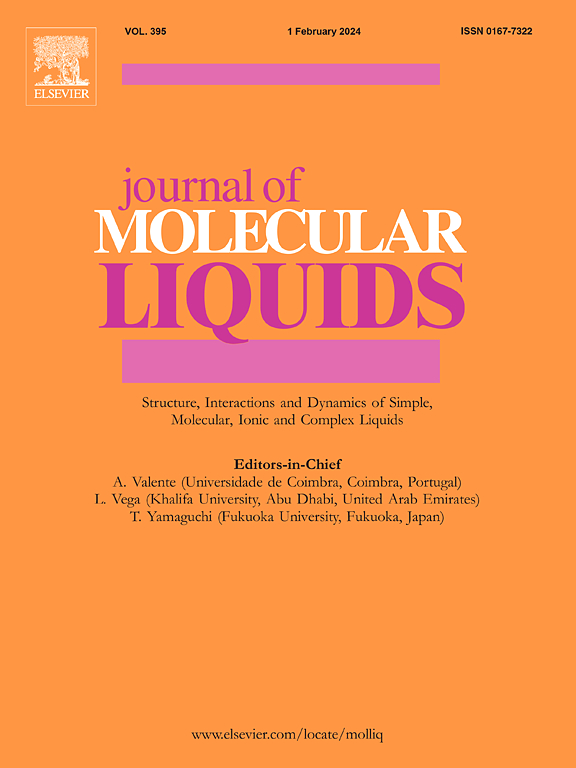一种富含皂苷的水皂提取物的表面和体积性质
IF 5.3
2区 化学
Q2 CHEMISTRY, PHYSICAL
引用次数: 0
摘要
富含皂苷的植物提取物越来越多地应用于许多工业领域。它们是大量生物分子的多组分混合物,其组成取决于植物的类型和制备方法。本研究以皂草根为原料,用水煮制了一种富含皂苷的提取物。通过测量各种浓度下的表面张力、密度、电导率和pH值来检验。基于表面张力、密度和电导率等温线,确定了临界胶束浓度(CMC)。此外,还计算了模型皂苷的偏体积和密度。由于SE的主要表面活性成分的亲水基团都是由糖单位组成的,因此我们选用蔗糖作为简单的头基(糖元)模型,而选用hederagenin作为皂苷尾部(糖元)的简单模型。为了更好地了解皂草提取物的吸附和胶束性质,通过模型液体(水、甲酰胺、甘油和二碘甲烷)的接触角值,测定了沉积在聚四氟乙烯(PTFE)表面的SE、hederagenin和蔗糖层的表面张力成分。利用这些数据,在溶液-空气界面和体中对SE进行了热力学分析。本贡献中描述的溶液-空气界面处的过量吉布斯浓度(Γ)和SE的CMC与文献中描述的不同,但仍然保持在相同的数量级内。富皂苷皂皂提取物的吸附和胶束自由能与Triton TX-165接近。本文章由计算机程序翻译,如有差异,请以英文原文为准。

Surface and volumetric properties of a saponin-rich aqueous soapwort extract
Saponin-rich plant extracts are increasingly being used in many fields of industry. They are multi-component mixtures of a large number of biomolecules whose composition depends on the type of plant and methods of their preparation. In this research, a saponin-rich extract (SE) was obtained by boiling the Saponaria officinalis L. (soapwort) roots in water. It was examined by measuring the surface tension, density, conductivity and pH in a wide range of concentrations. Based on the surface tension, density and conductivity isotherms, the critical micelle concentration values (CMC) were determined. Additionally, the partial volume of model saponin and its density were calculated. Since the hydrophilic groups of the major surface-active components of SE are composed of sugar units, saccharose was used as a simple headgroup (glycone) model, while hederagenin was chosen as a simple model of the saponin tail (aglycone). To better understand the adsorption and micellar properties of the soapwort extract, the surface tension components of SE, hederagenin and saccharose layers deposited on a polytetrafluoroethylene (PTFE) surface were determined from the contact angle values of the model liquids (water, formamide, glycerol and diiodomethane). Using these data, SE was thermodynamically analyzed at the solution-air interface and in the bulk. Both the excess Gibbs concentration (Γ) at the solution-air interface and CMC for SE described in the present contribution differ from those described in the literature, yet still remain within the same orders of magnitudes. The free energy of adsorption and micellization for the saponin-rich soapwort extract are close to those of Triton TX-165.
求助全文
通过发布文献求助,成功后即可免费获取论文全文。
去求助
来源期刊

Journal of Molecular Liquids
化学-物理:原子、分子和化学物理
CiteScore
10.30
自引率
16.70%
发文量
2597
审稿时长
78 days
期刊介绍:
The journal includes papers in the following areas:
– Simple organic liquids and mixtures
– Ionic liquids
– Surfactant solutions (including micelles and vesicles) and liquid interfaces
– Colloidal solutions and nanoparticles
– Thermotropic and lyotropic liquid crystals
– Ferrofluids
– Water, aqueous solutions and other hydrogen-bonded liquids
– Lubricants, polymer solutions and melts
– Molten metals and salts
– Phase transitions and critical phenomena in liquids and confined fluids
– Self assembly in complex liquids.– Biomolecules in solution
The emphasis is on the molecular (or microscopic) understanding of particular liquids or liquid systems, especially concerning structure, dynamics and intermolecular forces. The experimental techniques used may include:
– Conventional spectroscopy (mid-IR and far-IR, Raman, NMR, etc.)
– Non-linear optics and time resolved spectroscopy (psec, fsec, asec, ISRS, etc.)
– Light scattering (Rayleigh, Brillouin, PCS, etc.)
– Dielectric relaxation
– X-ray and neutron scattering and diffraction.
Experimental studies, computer simulations (MD or MC) and analytical theory will be considered for publication; papers just reporting experimental results that do not contribute to the understanding of the fundamentals of molecular and ionic liquids will not be accepted. Only papers of a non-routine nature and advancing the field will be considered for publication.
 求助内容:
求助内容: 应助结果提醒方式:
应助结果提醒方式:


